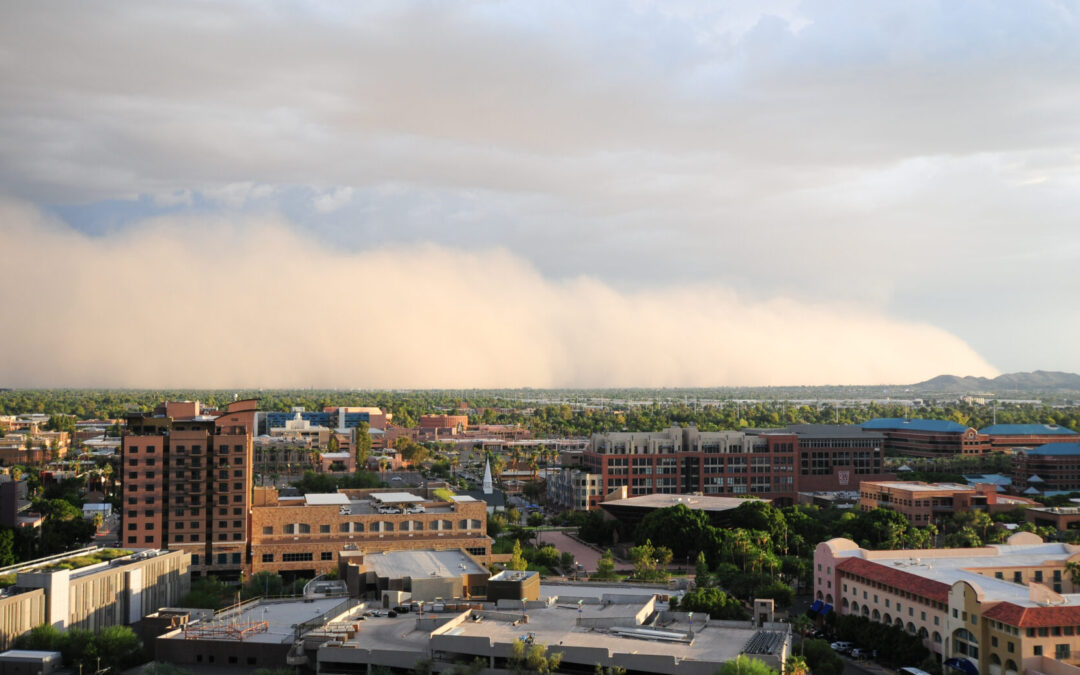Moving to Phoenix? This practical guide covers the real risks—monsoon, dust, localized flooding, and extreme heat—and how to protect your household with the right insurance, utility know-how, and readiness steps. And to help you understand; What does Arizona homeowners insurance not cover?
Why This Matters (and Why Phoenix Newbies Get Caught Off Guard)
Phoenix is dry—until it isn’t. Monsoon brings dust, downpours, and localized flooding; summer heat strains HVAC and the grid; and standard policies often exclude the exact damage you expect to be covered. Use this playbook to insure correctly, cut energy costs, and safeguard your home.
1) Homeowners & Renters Insurance 101 in Arizona
What Does Arizona Homeowners Insurance Not Cover?
- Typically covered: wind, hail, fire, theft.
- Typically not covered: flood (surface water). You need a separate flood policy (NFIP or private).
- Helpful add-ons: equipment breakdown (for HVAC), scheduled personal property, sewer/drain back-up.
Action steps:
- Get 2–3 quotes for HO/condo/renters; confirm your wind/hail deductible and available riders.
- Add flood insurance if you want flood damage covered—eligibility isn’t limited to mapped floodplains.
2) Are You Actually at Flood Risk? (Quick Check)
Flash flooding can occur outside mapped zones. Check both FEMA maps and local resources for your exact address.
Tip: Maps help, but curb grading, lot drainage, and nearby construction can change how water behaves on your street.
3) Monsoon & Dust Storms: Safety + Auto Claims
- If a dust wall approaches while driving: pull completely off the road, turn all lights off, set the brake, stay buckled, and wait.
- After wind/hail: document roof, windows, and landscaping damage immediately for claims; mitigation (e.g., tarps) is usually required.
- Auto: comprehensive coverage generally addresses wind-blown debris, sand/dust pitting, and hail; liability-only won’t.
4) Extreme Heat: Lower Your APS/SRP Bill Without Sacrificing Comfort
Time-of-use (TOU) plans can spike rates during peak hours. Verify the current peak windows in your utility portal and shift heavy usage to off-peak.
- APS plans & TOU details
- SRP Shade Tree Program (up to two free desert-adapted trees for eligible customers)
Five Quick Bill Wins
- Pre-cool before peak; coast during peak hours (confirm your plan’s peak window).
- Use a programmable/SMART thermostat; raise setpoint +2–4°F during peak.
- Seal/insulate attic and change filters monthly in peak season.
- Shade west/south exposures (films, awnings, trees); leverage SRP’s tree program if eligible.
- Run dishwashers, laundry, EV charging, and pool pumps off-peak.
5) Cooling Centers & Heat Relief (Save This Before July)
During heat waves or outages, use the county network for free cooled spaces and hydration sites (seasonal availability).
- Maricopa Heat Relief Network (typically May–Sept)
6) The Newcomer’s Home-Readiness Checklist
- Photograph roof, windows, and yard drainage (baseline + claims).
- Install surge protection; test GFCIs.
- Assemble a 72-hour kit: water (1 gal/person/day), electrolyte packets, battery/solar lights, power banks, first-aid, pet supplies.
Before Monsoon (June)
- Clean gutters and yard drains; create gravel swales to pull water away from the foundation.
- Strap water heater; trim trees; secure outdoor furniture.
- Stock N95s and goggles for dust; keep a set in the car.
- Bookmark local emergency resources: cooling centers, flood maps, county viewer, and dust-driving safety tips.
During Dust/Monsoon
- Driving: follow the “Pull Aside, Stay Alive” steps above; never drive into a dust wall or floodwater.
- Home: unplug sensitive electronics; keep phones topped off; avoid opening exterior doors during high winds.
If You File a Claim
- Take time-stamped photos/video; keep receipts for tarps, pumps, fans (mitigation costs are often reimbursable).
- File promptly via your carrier app/portal and upload documentation to speed the adjuster visit.
- Keep damaged items until the adjuster inspects; log contractor licenses and written estimates.
FAQs
Do I need flood insurance in Phoenix if I’m not in a floodplain?
If you want flood damage covered, yes. Standard policies exclude flood. NFIP or private flood coverage is available to most addresses and can be affordable in lower-risk zones.
What are the most valuable riders for Phoenix homes?
Flood, sewer/drain back-up, and equipment breakdown. Consider scheduled personal property for high-value items.
Are dust and hail damages to my car covered?
Usually under comprehensive auto. Liability-only won’t help with storm damage.
Does insurance cover power surges or heat-related HVAC failure?
Surge damage may be covered; wear and tear is not. Whole-home surge protection and an equipment breakdown rider reduce surprises.
Are rooftop solar panels and EV chargers covered?
Permanently attached panels are typically part of the dwelling; hard-wired EV chargers may be covered. Tell your insurer about installs and adjust limits as needed.
Helpful Links
- Utility Setup Simplified and Energy-Efficient Living.
- Adapting to Desert Living and Phoenix Weather.
- Change Driver’s License & Register Your Car.
- Phoenix Storm & Heat Readiness
- Cooling center and flood map
Thinking of making a move to Phoenix? Request your FREE copy of the Phoenix Relocation Guide!

